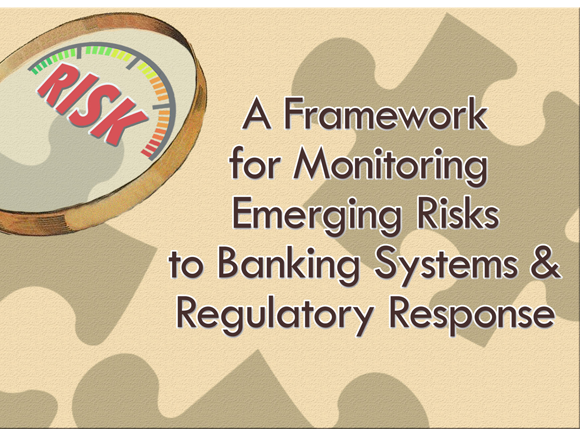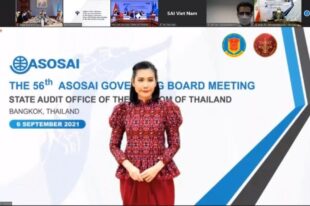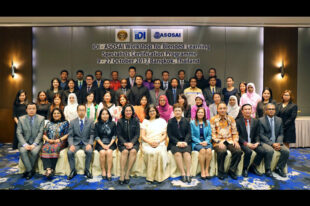Emerging Risk Framework for Banking Systems, Regulatory Response


By Stefanie Jonkman and M’Baye Diagne, United States Government Accountability Office
Financial institutions and markets provide essential services to the U.S. and global economies. However, weaknesses in federal oversight have contributed to the thrift and bank crises in the 1980s and the financial crisis experienced from 2007-2009. For example, the resolution of banks and thrifts during these crises cost federal bank and thrift insurance funds over $165 billion and resulted in unprecedented taxpayer assistance. In a 2015 report, “Bank Regulation: Lessons Learned and a Framework for Monitoring Emerging Risks and Regulatory Responses,” the U. S. Government Accountability Office (GAO) identified lessons learned from regulatory weaknesses or shortcomings leading up to past crises. These lessons include the importance of:
Early and forceful action. In each financial crisis, regulators identified early on banks with weak management practices that were engaging in risky activities. However, they were not always effective in correcting such problems before the banks became under-capitalized and failed.
Forward-looking assessments of risk. The crises revealed limitations in supervisory tools for monitoring and addressing emerging risks at banks. Examiners did not always incorporate forward-looking information when rating a bank’s soundness and risk exposures.
Considering risks from the broader financial system. The 2007–2009 financial crisis highlighted the need for regulators to look not only at individual and groups of banks but also across the financial system to identify emerging risks.
Federal banking regulators have taken steps to incorporate these lessons learned and improve their ability to identify and respond to emerging risks. For example, they have instituted more granular tracking of bank compliance with examination findings to address emerging problems in a timely manner, and they have incorporated more forward-looking elements into supervisory tools.
As regulators implement revised supervisory approaches, a continual assessment of their efforts could help identify oversight weaknesses and ways to enhance their effectiveness. To that end, GAO developed a framework to monitor (1) known emerging risks to the banking system’s safety and soundness and (2) regulatory responses to these risks, in part to identify trends that might signal a weakening of regulatory oversight. Supreme Audit Institutions and others also may use the framework to monitor regulatory efforts.
Monitoring Emerging Risks The framework’s first part incorporates quantitative and qualitative financial indicators that track and analyze emerging risks in three areas: bank financial condition and performance; asset markets; and the broader economy and global trends. The routine tracking and review of these indicators helps inform users of key trends, known and evolving risks to the banking system and the context in which regulators are responding to risks.
Bank Financial Condition and Performance Financial indicators that capture bank condition and performance provide insight into emerging credit, liquidity, market and other risks. For example, these indicators can be used to monitor capital levels and leverage, asset quality, earnings trends and funding liquidity. They may also help identify risk buildups or deteriorating credit trends.
Asset Markets Other financial indicators provide insights on price and other changes in asset markets, including the residential and commercial real estate, equity and debt and commodities markets. Such indicators also can be used to track changes in leverage and volatility, such as corporate and household debt-to-income ratios, that could affect the banking system.
Broader Economy and Global Trends Financial indicators on the overall health of the broader economy, such as household income and debt, unemployment and gross domestic product, allow users to assess the economy and its potential impact on bank performance and profitability. They can also provide insights on interconnectedness and risk exposures between the financial sector and broader economy.
Monitoring Regulatory Response The framework’s second part focuses on monitoring regulatory responses to emerging risks. Such monitoring serves to identify regulatory trends and flag issues for further review. In this context, it is important to identify the tools regulators use to address emerging risks and the goals of the tools and their potential tradeoffs. A number of sources can provide insight into regulators’ identification of, and response to, emerging risks, including:
- Examination and enforcement data: Trend analyses of supervisory ratings of banks, which reflect regulatory assessment of their risk exposures for capital, asset quality, management, earnings, liquidity and sensitivity to market risk.
- Enforcement actions: Trend analyses of informal and formal enforcement actions taken by regulators against banks.
- Agency guidance and regulations: Tracking and analyses of guidance and regulations issued by regulators in response to emerging issues.
Federal banking regulators serve to promote the safety and soundness of banks and the banking system. Effective regulation and supervision can reduce the probability and magnitude of future financial crises and enhance market confidence in the banking sector. In turn, continual monitoring of banking regulators’ oversight efforts can serve as a strategic tool for identifying audit opportunities for more targeted and timely assessments of these efforts. GAO has implemented its framework and will refine it as new sources of qualitative and quantitative information as new analytical tools become available.
The INTOSAI Governing Board established the Working Group on Financial Modernization and Regulatory Reform (WGFMRR) in 2012 to enhance INTOSAI members’ expertise and capabilities to meet the challenges associated with overseeing national and global financial systems.
Under its terms of reference, the WGFMRR aims to assist Supreme Audit Institutions (SAIs) in addressing these challenges by developing tools and knowledge-sharing opportunities for evaluating national reforms; establishing mechanisms for sharing information on the progress of reforms among INTOSAI and international bodies; systematically tracking information on reforms at national and international levels; and identifying gaps and emerging risks where additional study by the WGFMRR is needed. The WGFMRR has organized its members into three subgroups to meet these objectives, with China, Canada, and the United States chairing the subgroups, respectively.
Learn more about the WGFMRR by visiting http://www.contraloria.cl/Wdpress/Financial-Modernization/





